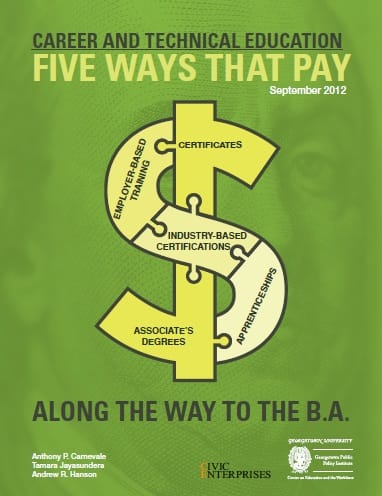 At 31 percent, the United States currently ranks second among OECD nations—behind Norway—for the percentage of its workforce with a four-year college education. That’s the good news. The bad news is that we rank sixteenth for the percentage of our workforce with a sub-baccalaureate education (think: postsecondary and industry-based certificates, associate’s degrees). Yet a swath of jobs in America calls for just that sort of preparation, which often begins in high school. Dubbed “middle jobs” in this report by the Center on Education and the Workforce, these employment opportunities pay at least $35,000 a year and are divided among white- and blue-collar work. Yet they are largely ignored in our era of “college for all.” In two parts, this report delineates five major categories of career and technical education (CTE), then lists specific occupations that require this type of education. It’s full of facts and figures and an excellent resource for those looking to expand rigorous CTE in the U.S. Most importantly, it presents this imperative: Collect data on students who emerge from these programs. By tracking their job placements and wage earnings, we can begin to rate CTE programs, shutter those that are ineffective, and scale up those that are successful. If CTE is ever to gain traction in the U.S.—and shed the stigma of being low-level voc-tech education for kids who can’t quite make it academically—this will be a necessary first step.
At 31 percent, the United States currently ranks second among OECD nations—behind Norway—for the percentage of its workforce with a four-year college education. That’s the good news. The bad news is that we rank sixteenth for the percentage of our workforce with a sub-baccalaureate education (think: postsecondary and industry-based certificates, associate’s degrees). Yet a swath of jobs in America calls for just that sort of preparation, which often begins in high school. Dubbed “middle jobs” in this report by the Center on Education and the Workforce, these employment opportunities pay at least $35,000 a year and are divided among white- and blue-collar work. Yet they are largely ignored in our era of “college for all.” In two parts, this report delineates five major categories of career and technical education (CTE), then lists specific occupations that require this type of education. It’s full of facts and figures and an excellent resource for those looking to expand rigorous CTE in the U.S. Most importantly, it presents this imperative: Collect data on students who emerge from these programs. By tracking their job placements and wage earnings, we can begin to rate CTE programs, shutter those that are ineffective, and scale up those that are successful. If CTE is ever to gain traction in the U.S.—and shed the stigma of being low-level voc-tech education for kids who can’t quite make it academically—this will be a necessary first step.
SOURCE: Anthony P. Carnevale, Tamara Jayasundera, Andrew R. Hanson, Career and Technical Education: Five Ways that Pay Along the Way to the B.A. (Washington, D.C.: Center on Education and the Workforce, Georgetown University, September 2012).
